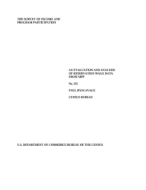An Evaluation and Analysis of Reservation Wage Data from SIPP
An Evaluation and Analysis of Reservation Wage Data from SIPP
This paper reports the general results of research undertaken by Census Bureau staff. The views expressed are attributable to the author and do not necessarily reflect those of the Census Bureau.
Introduction
The reservation wage is an important element in an individual’s decision to participate in the labor market. It represents the wage a worker would require to give up an additional hour of leisure (Hammermesh and Rees, 1984). In working and is commonly thought of as the lowest wage a person would accept for market work.
The reservation wage of an individual is a subjective value and can be affected by many factors. The most obvious is the type of work a person is looking for or considering. Other factors could include the traveling distance to the job, the working conditions, the sources of other income in the household, and so on. The precise impact of each of these factors on one’s reservation wage is difficult to quantify. Nevertheless, the concept remains central to much of contemporary labor economic theory and interest in any empirical evidence of it remains high.
In the fifth round of interviews of the 1984 panel of the Survey of Income and Program Participation (SIPP), a series of questions were asked about the reservation wage, job search, and reasons for not participating in the labor force. SIPP is a longitudinal household survey designed to provide comprehensive information on the economic situation of households and persons in the country. The reservation wage questions were part of the survey’s topical module which in this wage also contained questions on child care, welfare history and child support, support for nonhousehold members, and work related expenses.
Because of the potential usefulness of reservation wage data, and also their political sensitivity, a thorough evaluation of them is essential. This paper is divided into two parts. The first part discusses how the date were collected and the various qualitative issues concerning the data. The second part presents some of the data in an analytical context. Both parts should provide potential users with some insights into the nature and quality of the data.
Others in Series
Working Paper
Working Paper
Working Paper




